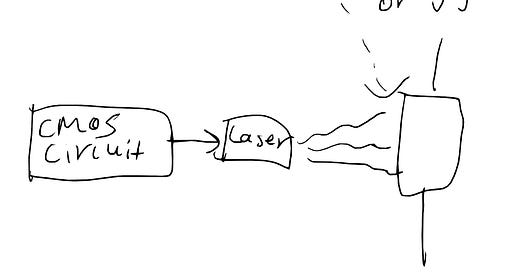Optical Conversion of CMOS <> Superconducting Signals
Potentially interesting for quantum computing, quantum sensors, digital superconducting logic and cryogenic electronics
Overview
Converting between CMOS signals and various superconducting signal methods is challenging, and is relevant to applications like quantum computing.
Key Idea
I propose to exploit an optical method for doing so, a CMOS circuit* drives a laser**, and that light is used to switch a superconductor or a Josephson Junction.
*could be very simple
** or a micro-LED, nano-LED, nano-antenna backed LED, etc.
This has the advantage of thermal isolation (optics allows thermally isolating the CMOS and the superconducting components), as well as potentially exploiting other switching phenomena.
Thermal vs Non-Thermal Switching
How do we use light to switch a superconductor? Broadly, we could do so thermally (inefficient, but seems more mature), or non-thermally.
Thermal Switching
The nanocryotron (“nTron”) device uses thermal switching to achieve this effect. An optical method could potentially also operate using a thermal mechanism.
In this case, an optical method might have the benefit of being thermally isolated from the cryogenic environment.
Nanocryotron:
Fig. 1, from https://journals.aps.org/prapplied/abstract/10.1103/PhysRevApplied.14.054011
In a thermally switched optical conversion device, the laser would provide the energy to heat the superconducting channel.
Optical nanoantennae could potentially be used to concentrate the light, allowing for improved characteristics. Optical nanoantenna based concentration has been shown before: Near-Infrared Photodetector Enhanced by an Open- Sleeve Dipole Antenna (note that in our case, in contrast to the paper, the goal would be to create a concentrated thermal effect, not an electrical one).
Previous work seems to show the validity of optical switching via thermal mechanisms: Rapid optical switching of latched electrical resistance in a high-Tc superconducting tape | Journal of Applied Physics | AIP Publishing
Nanocyrotron papers:
Non-Thermal Switching
Non-thermal, direct optical switching also seems possible, based on reports from the literature. This could be far more efficient than thermal switching, which effectively replaces the nTron’s heater element with an optical heater (the laser).
https://phys.org/news/2015-02-superconductivity.html
Although the switching time seems extremely long, not usable as-is for signal conversion
Optical switching of HTS band reject resonators | IEEE Journals & Magazine





